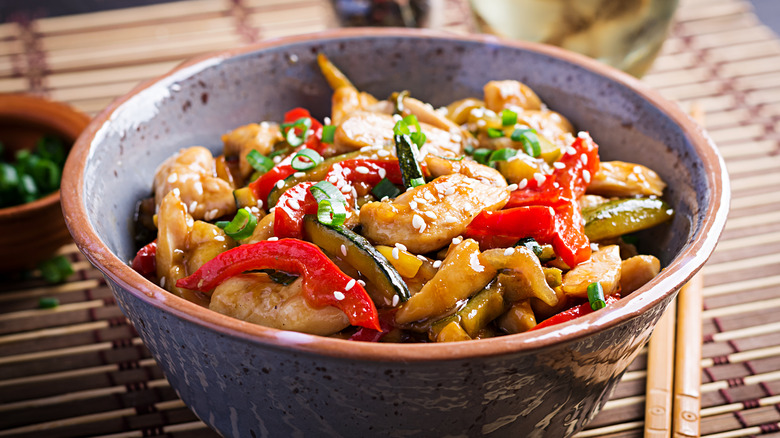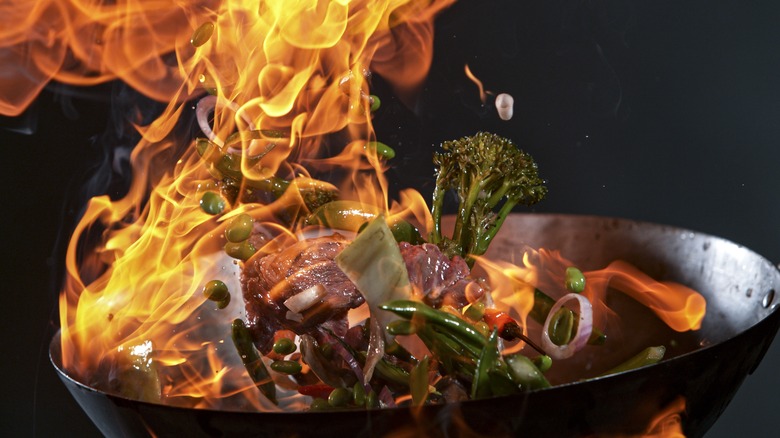The Biggest Mistake You're Making With Chicken And Vegetable Stir-Fry
There might not be a better, quicker, more crowd-pleasing dinner than stir-fry. Cook some rice, prepare the ingredients, stir-fry, and serve. Maybe the biggest stir-fry debate is whether you need to use a wok, or if a non-stick skillet is okay. The Los Angeles Times has tackled that conundrum and the choice is really up to you.
According to MasterClass, stir-fry is a Chinese cooking method that uses extremely high heat to cook food quickly. The food needs to be cut into small, uniform pieces so that they can cook evenly. That size also helps the food to cook through before scorching. Another way to use the highest of heat without burning the food is to keep it moving, hence the name. Stir-fry is both the cooking technique and a family of dishes that are stir-fried. For example, beef and broccoli, kung pao shrimp, fried rice, and vegan tofu stir-fry.
All of those recipes follow a general guideline that allows things to move quickly once the cooking begins. Start with choosing a sauce, then marinate the protein, and prep the rest of the ingredients. This is usually cutting vegetables, and mincing aromatics, like ginger and garlic. This is also the time to grab any utensils you'll need and a serving platter, or bowl. Don't forget to preheat the pan. Stir-fry the protein, add the aromatics, then the vegetables, coat with sauce, remove from heat, and serve.
Keep your meat and veggies separate
Of course, it's not quite that simple. There are best practices for each of those steps. Of all the potential stir-fry pitfalls, the worst thing you can do is to try and speed up an already fast process by cooking the protein and vegetables at the same time, says Food Network.
Adding the chicken will lower the temperature in the pan. There's no avoiding that. If the chicken isn't crowded into the pan, the heat will quickly recover. Add too much chicken to the pan and the moisture released during cooking can't evaporate, and the pan won't reheat. The result is more like steaming than stir-frying, and adding the vegetables to the chicken has the exact same sad result. The chicken will overcook before it colors, and the vegetables will simmer to mush.
Instead, follow the steps for this easy chicken stir-fry recipe. Remove the chicken from the pan as soon as it's cooked through, and set it aside. Then, stir-fry the vegetables. It might even be a good idea to stir-fry the various vegetables separately. That will ensure they're cooked perfectly, and you won't run the risk of overcrowding the pan. When the final vegetables are cooked, add the sauce to thicken, then all of the meat and vegetables that have been set aside. Toss these just long enough to heat through, and serve.
Simple chicken and vegetable stir-fry upgrades
Once you've avoided that big stir-fry mistake, The Woks of Life take a closer look at the rest of the stir-fry steps. Plus, they provide a great all-purpose stir-fry sauce recipe. Most of the ingredients are things that have become common pantry ingredients. If they're unfamiliar, a list explaining essential Chinese ingredients will spell them out.
America's Test Kitchen takes a closer look at cooking the different vegetables common in a stir-fry. Because vegetables cook at different rates, they break down vegetables into three batches. The first is longer cooking vegetables that might even need the benefit of a lid to trap some steam to cook through — broccoli and cauliflower, for example.
The second batch is the vegetables that cook quickly via traditional stir-frying, like sliced carrots, celery, shredded cabbage, mushroom, onions, and peppers. The third batch consists of bean sprouts, spinach, and fresh herbs, as they take almost no time to cook and should just be folded in at the end.
After taking care to not make a watery stir-fry by cooking the chicken and vegetables separately, don't serve up a watery sauce. Cornstarch is the secret ingredient that will take your stir-fry up a final notch.


